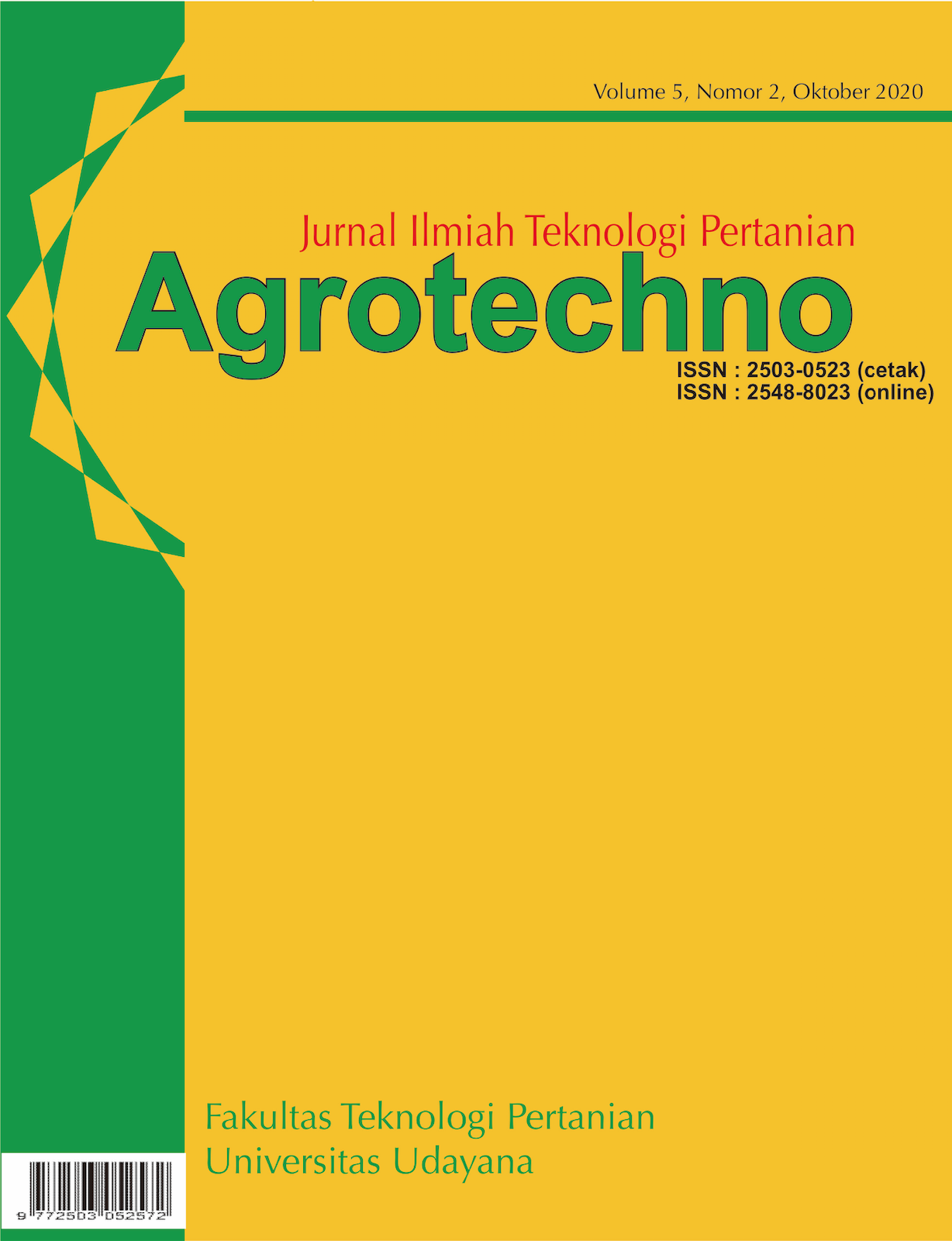Aktivitas Antioksidan dan Evaluasi Sensoris Teh Herbal Bunga Gumitir (Tagetes erecta L.)
Abstract
Bunga gumitir memiliki manfaat yang baik bagi kesehatan karena mengandung komponen bioaktif berupa flavonoid, fenol, dan karotenoid berupa lutein sehingga sangat berpotensi digunakan sebagai teh herbal. Penelitian ini bertujuan untuk mendapatkan teknik pengeringan teh herbal bunga gumitir yang tepat sehingga menghasilkan karakteristik teh herbal bunga gumitir dengan komponen bioaktif dan antioksidan yang tinggi serta sensoris yang baik. Pengeringan dilakukan dengan 5 teknik yang berbeda yaitu pengeringan matahari, pengeringan oven, pengeringan dingin, pengeringan udara, dan pengeringan sangrai. Parameter yang diamati meliputi kadar air, total fenol, total flavonoid, aktivitas antioksidan (IC50) serta pengujian sensoris air seduhan teh herbal bunga gumitir (warna, aroma, rasa, dan penerimaan keseluruhan). Hasil penelitian menunjukkan bahwa pengeringan dingin mampu menghasilkan teh herbal dengan karakteristik terbaik yaitu kadar air sebesar 6,86%, total fenol sebesar 83,88 mg GAE/g ekstrak, total flavonoid sebesar 373,06 mg QE/g ekstrak, nilai IC50 sebesar 257,65 mg/L, karakteristik sensoris paling disukai dengan rasa agak khas bunga gumitir, rasa tidak asam, dan berwarna merah kekuningan.
Gumitir flower had good benefits for health because their bioactive components contain flavonoids, phenols, and carotenoids like lutein so that gumitir flower were potentially used as herbal tea. The research was conducted to obtain the appropriate gumitir flower tea drying technique to produced the characteristics of gumitir herbal tea with high bioactive and antioxidant components and good sensory. Drying were carried out with 5 different techniques, namely sun drying, oven drying, cold drying, air drying, and roasting drying. Parameters observed included water content, total phenol content, total flavonoid content, antioxidant activity (IC50), and sensory testing of gumitir flower herbal tea (color, aroma, taste, and overall reception). The results showed that cold drying was able to produced herbal tea with the best characteristics with water content was 6.86%, total phenol content was 83.88 mg GAE/g extract, total flavonoid content was 373.06 mg QE/g extract, IC50 was 257.65 mg/L, sensory characteristics were most preferred with a rather typical taste of gumitir flower, not sour and yellowish red.
Downloads
References
Benni, S., P.V. Pattar, dan Ramalingappa. 2018. Evaluation of antioxidant properties of herbal tea powders. American Journal of Biomedical Sciences. 10(4):217-222. DOI:10.5099/aj180400222.
Bernard, D., A.I. Kwabena, O.D. Osei, G.A. Daniel, S.A. Elom, dan A. Sandra. 2014. The effect of different drying methods on the phytochemicals and radical scavenging activity of ceylon cinnamon (Cinnamomum zeylanicum) plant parts. European Journal of Medicinal Plants. 4(11):1324-1335. DOI: 10.9734/EJMP/20 14/11990.
Chan, K.C., J.S. Cheng, S. Fan, I.Y. Zhou, J. Yang, E.X. Wu. 2012. In vivo evaluation of retinal and callosal projections in early postnatal development and plasticity using manganese-enchanced MRI and diffusion tensor imaging. Neuroimage. 59:2274-2283. DOI: 10.1016/j.neuroimage.2011.09 .05 5.
Fitriansyah, S.N., D.L. Aulifa, Y. Febriani, dan E. Sapitri. 2018. Correlation of total phenolic, flavonoid and carotenoid content of phyllanthus emblica extract from bandung with DPPH scavenging activities. Pharmacognosy Journal. 10(3):447-452. DOI: 10.5530/pj.2018.3.73.
Garcia, C.A., G. Gavino, M.B. Mosqueda, P. Hevia, dan V.C. Gavino. 2007. Correlation of tocopherol, tokotrienol, γ oryzanol and total polyphenol content in rice bran with different antioxidant capacity assays. Food Chem. 102:1228-1232. DOI: 10.1016/j.foodchem.2006.07.0 12.
Ingkasupart, P., B. Manochai, W.T. Song, dan J.H. Hong. 2015. Antioxidant activities and lutein content of 11 marigold cultivars (Tagetes spp.) grown in Thailand. Food Science and Technology. 35(2):380-385. DOI: http://dx.doi.org/10.1590/1678-457 X.6663.
Kamiloglu, S., G. Toydemir, D. Boyacioglu, J. Beekwilder, R.D. Hall, dan E. Capanoglu. 2015. A Review on the Effect of Drying on Antioxidant Potential of Fruits and Vegetables. Critical Reviews in Food Science and Nutrition. 56(1):110-129. DOI: 10.1080/10408398.2015.1045969.
Khan, R. A., M.R. Khan, S. Sahreen, dan M. Ahmed. 2012. Evaluation of phenolic contents and antioxidant activity of various solvent extracts of Sonchus asper (L.) Hill. Chemistry Central Journal. 6:1-7. DOI: https://doi.org/10.1186/1752-153X-6-12.
Kyi, T.M., W.R.W. Daud, A.B. Mohammad, M.W. Samsudin, A.A.H. Kadhum, dan M.Z.M. Talib. 2005. The kinetics of polyphenol degradation during the drying of malaysian cocoa beans. International Journal of Food Science and Technology. 40(3):323-331. DOI: 10.1111/j.1365-2621.2005.00959.x.
Lee, J., D. Chambers, dan I.V.E, Chambers. 2013. Sensory and instrumental flavor changes in green tea brewed multiple times. Foods. 2:554-571. DOI:10.3390/fo ods2040554.
Moliner, C., L. Barros, M.I. Dias, V. Lopez, E. Langa, I.C.F.R. Ferreira, dan C. Gómez-Rincón. 2018. Edible flowers of Tagetes erecta L. as functional ingredients: phenolic composition, antioxidant and protective effects on Caenorhabditis elegans. Nutrients. 1-14. DOI:10.3390/nu1 0122002.
Nagaya, K., Y. Li, Z. Jin, dan M. Fukumuro. 2005. Low temperature desicant based food drying system with airflow and temperature control. Journal of Food Engineering. 71-77. DOI: 10.1016/j.jfoode ng.2005.03.-51.
Paramitha, D.A.I., N.M. Suaniti, dan J. Sibarani. 2018. Aktivitas antioksidan bunga pacar air merah (Impatiens balsamina L.) dan bunga gumitir (Tagates erecta L.) dari limbah canang. Journal Chimica et Natura Acta. 6(1):8-11. DOI: 10.24198/cna.v6.n1 .16447.
Pascariu, S.M., I.M. Pop, dan A. Albu. 2014. Degradation degree of polyphenols depending on drying temperature of the grape pomace. Bulletin UASVM Animal Science and Biotechnologies. 71(2):212-217. DOI: 10.15835/buasvmcn-asb:10311.
Rababah, T.M., K. Ereifej, M. Al-u’datt, M. Alhamad, M. Al-Mahasneh, J. Andrade, B. Altarifi, dan A. Almajwal. 2015. Effects of drying process on total phenolics, antioxidant activity and flavonoid contents of common mediterranean herbs. International Journal of Agricultural and Biological Engineering. 8(2):145-150. DOI: 10.3965 /j.ijabe.20150802.1496.
Shetty, L.J., F.M. Sakr, K. Al-Obaidy, M.J. Patel, dan H. Shareef. 2015. A brief review on medicinal plant Tagetes erecta Linn. Journal of Applied Pharmaceutical Science. 5(3):091-095. DOI: 10.7324/JAP S.2015.510.S16.
Siddhu, N. dan J. Saxena. 2017. Evaluation of invitro antioxidant activity of flowers of Tagetes erecta. International Journal of Pharmacognosy and Phytochemical Researc. 9(7):975-979. DOI: 10.2558/phy to.v9i07.11166.
Singh R, P.K. Verma, dan G. Singh. 2012. Total phenolic, flavonoids and tannin contents in different extracts of Artemisia absinthium. Intercult. Ethnopharmacol. 1(2):101-104. DOI: 10.5455/jice.2012052 5014326.
Syafarina, M., Irham, T., Edyson. 2017. Perbedaaan Total Flavonoid antara Tahapan Pengeringan Alami dan Buatan pada Ekstrak Daun Binjai (Mangifera caesia). Skripsi. Fakultas Kedokteran Gigi, Universitas Lambung Mangkurat, Banjarmasin.
Syafrida, M., S. Darmanti, dan M. Izzati. 2018. Pengaruh suhu pengeringan terhadap kadar air, kadar flavonoid dan aktivitas antioksidan daun dan umbi rumput teki (Cyperus rotundus L.). Jurnal Berkala Ilmiah Biologi. 20(1):44-50. DOI: 10.147 10/bioma.20.1.44-50.
Teixeira, T. S., R.C. Vale, R.R. Almeida, T. P. S. Ferreira, dan L.G.L. Guimaraes, L. 2017. Antioxidant potential and its correlation with the contents of phenolic compounds and flavonoids of methanolic extracts from different medicinal plants. Revista Virtual de Quimica 9(4):1546-1559. DOI: 10.21577/1984-6835.201700 90.
Teshome, K., A. Debela, dan W. Garedew. 2013. Effect of drying temperature and duration on biochemical composition and quality of black tea (Camellia sinensis L.). Asian Journal of Plant Sciences. 12: 235-240. DOI: 10.3923/ajps.2013.235. 240.
Widarta, I.W.R., I.D.G.M. Permana, dan A.A.I.S. Wiadnyani. 2018. Kajian waktu dan suhu pelayuan daun alpukat dalam upaya pemanfaatannya sebagai teh herbal. Jurnal Aplikasi Teknologi Pangan. 7(2):55-61. DOI: 10.17728/jatp.2163.










